More Sarajevo Highlights
Last week, I wrote a post about many of the highlights of a visit to the capital of Bosnia and Herzegovina. But there are so many must-see sites in this fascinating city that straddles East and West, that I continue my highlights this week.
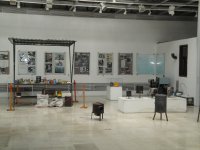 Revolution Museum/Historical Museum – open weekdays until 14:00. This museum is just beside the National Museum and its façade still shows damage from sniper fire. After all, the museum is located across from the Holiday Inn, on the section of Maršala Tita Street that was once well known as the infamous Sniper Alley. The museum has a small, but interesting exhibit on the history of Bosnia, from its founding, through Ottoman and Habsburg rule and as part of Yugoslavia. The photo exhibition of the siege of Sarajevo is moving, and this alone makes this museum a must for your visit.
Revolution Museum/Historical Museum – open weekdays until 14:00. This museum is just beside the National Museum and its façade still shows damage from sniper fire. After all, the museum is located across from the Holiday Inn, on the section of Maršala Tita Street that was once well known as the infamous Sniper Alley. The museum has a small, but interesting exhibit on the history of Bosnia, from its founding, through Ottoman and Habsburg rule and as part of Yugoslavia. The photo exhibition of the siege of Sarajevo is moving, and this alone makes this museum a must for your visit.
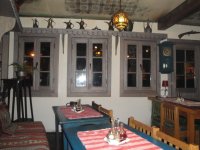 Inat Kuća restaurant – This was my favorite restaurant in Sarajevo. I’m glad I ignored my guide book’s claim that the service is consistently poor. I’d be hard-pressed to remember friendlier service. The décor is traditionally Bosnian, from Ottoman times. In fact, this house has an interesting history. It’s known as the ‘Spite House’, because in a development phase of Sarajevo’s old town, the house had to be demolished, but the owner simply moved it, stone by stone, across the river from its old location. The meat-based Bosnian specialties are wonderfully flavorful and present well. The begova ćorba, the traditional soup of the lords, a rich chicken cream soup, isn’t to be missed.
Inat Kuća restaurant – This was my favorite restaurant in Sarajevo. I’m glad I ignored my guide book’s claim that the service is consistently poor. I’d be hard-pressed to remember friendlier service. The décor is traditionally Bosnian, from Ottoman times. In fact, this house has an interesting history. It’s known as the ‘Spite House’, because in a development phase of Sarajevo’s old town, the house had to be demolished, but the owner simply moved it, stone by stone, across the river from its old location. The meat-based Bosnian specialties are wonderfully flavorful and present well. The begova ćorba, the traditional soup of the lords, a rich chicken cream soup, isn’t to be missed.
 Bosnian coffee – Okay, you simply cannot visit Sarajevo and not take time out in one of the city’s many cafes to enjoy this tradition. During the war in Bosnia, I was working in the Czech Republic and Austria and on weekends I used to volunteer with camps housing the Bosnian refugees. Every visit began with this coffee, which is a part of local traditions originating from Ottoman times and I was quickly hooked on the strong coffee and lively discussions that accompanied it.
Bosnian coffee – Okay, you simply cannot visit Sarajevo and not take time out in one of the city’s many cafes to enjoy this tradition. During the war in Bosnia, I was working in the Czech Republic and Austria and on weekends I used to volunteer with camps housing the Bosnian refugees. Every visit began with this coffee, which is a part of local traditions originating from Ottoman times and I was quickly hooked on the strong coffee and lively discussions that accompanied it.
The coffee is served in the džezva, the long-handled, copper pot where the coffee has been twice boiled. You pour it into the small cups… but don’t sip too close to the bottom or you’ll get a mouthful of coffee grinds! I learned this lesson years ago after a few mistakes. The coffee comes with a sugar cube, but the Bosnians don’t mix the sugar with their coffee. They dip it into the coffee and then bite the sugar-coffee mixture, allowing it to dissolve in their mouths and flavor the coffee they’re sipping. I wasn’t a very good student, unfortunately, but the Bosnians also showed me how to read my future in my cup’s coffee grinds. Next time I’ll pay closer attention…
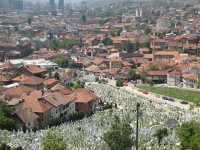 Views from the hillsides of Sarajevo – Sarajevo is surrounded by lovely, verdant hills. Unfortunately, it was these same hills that made it so easy for the snipers to attack the residents of the city during the siege. If you’re visiting Sarajevo, you should climb up these hills to get a view over the Old Town. Unfortunately, a visitor can’t help but notice all the modern graveyards that dot Sarajevo’s hillsides, with gravestones all indicating the years of death between 1992 and 1995, the years of the siege.
Views from the hillsides of Sarajevo – Sarajevo is surrounded by lovely, verdant hills. Unfortunately, it was these same hills that made it so easy for the snipers to attack the residents of the city during the siege. If you’re visiting Sarajevo, you should climb up these hills to get a view over the Old Town. Unfortunately, a visitor can’t help but notice all the modern graveyards that dot Sarajevo’s hillsides, with gravestones all indicating the years of death between 1992 and 1995, the years of the siege.
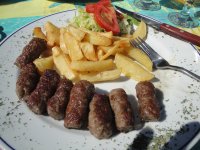 Ćevapčići- These are spicy sausages you find absolutely everywhere and it makes a quick, inexpensive, and tasty lunch if you stop at one of the many establishments cooking up ćevapčići in Sarajevo’s old town. The smell of grilling meat will lead you there.
Ćevapčići- These are spicy sausages you find absolutely everywhere and it makes a quick, inexpensive, and tasty lunch if you stop at one of the many establishments cooking up ćevapčići in Sarajevo’s old town. The smell of grilling meat will lead you there.
Kozja Ćuprija (Goat Bridge) – Be sure to make time for this little walking excursion. Pass the National Library in the Old Town and head east, following the river to the rugged canyons that begin just at the edge of town.
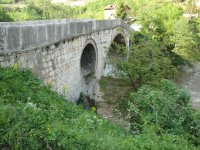 This is a 5 km circuit, with a pleasant walking path filled with walkers, joggers and cyclists. There are plenty of benches to sit and rest and trees donated by all the foreign ambassadors after Sarajevo’s trees were all cut down for firewood during the siege. You’ll see the dedication plaques along the walkway. I was stunned to see the nature grow so wild so close to the city center and I was surprised to see the steep cliffs were popular with young rappellers.
This is a 5 km circuit, with a pleasant walking path filled with walkers, joggers and cyclists. There are plenty of benches to sit and rest and trees donated by all the foreign ambassadors after Sarajevo’s trees were all cut down for firewood during the siege. You’ll see the dedication plaques along the walkway. I was stunned to see the nature grow so wild so close to the city center and I was surprised to see the steep cliffs were popular with young rappellers.
Walk until you reach the stunning and elegant Ottoman Bridge (10 meters high at its arch). This was built by the Ottomans prior to 1550 (the first time it appears in a travel journal). It is here that viziers were officially welcomed on their journey to the city and where Bosnian travelers began their journeys on the Hajj to Mecca.
So now you have plenty of reasons to go visit Sarajevo. Enjoy your trip!
[…] are many more highlights of a Sarajevo visit. I’ll continue my tips next week for ideas of what to see during your next visit to this fascinating Balkan capital. Share […]
Great post, Kimberly! Thanks for sharing it.
Thanks, Julia! It’s really an interesting place.